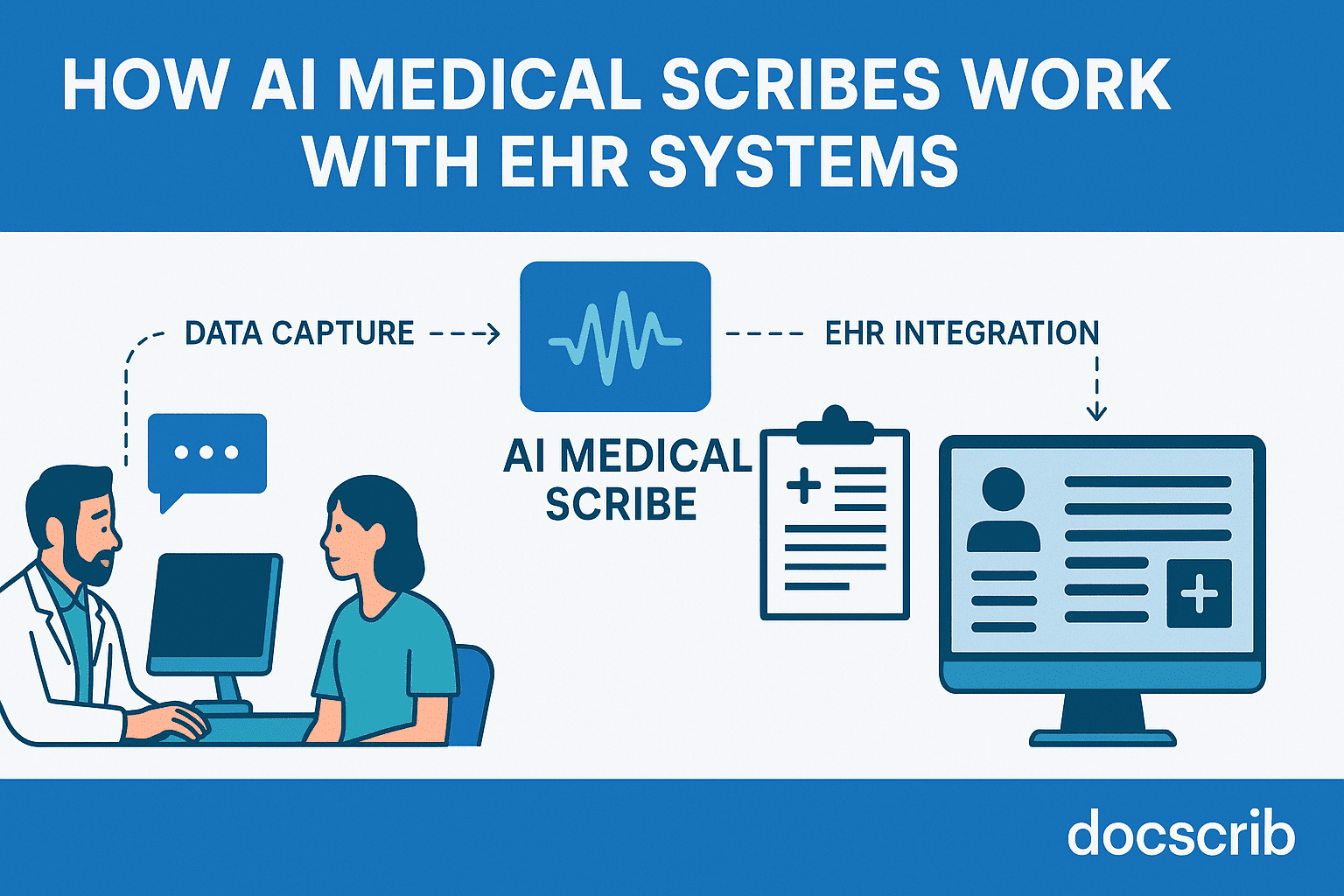Updated on: July 11, 2025
In today’s fast-paced healthcare environment, the burden of clinical documentation has become one of the leading causes of physician burnout. Hours spent on Electronic Health Records (EHRs) mean less time for patient care, greater stress, and lower job satisfaction.
Enter the AI Medical Scribe—an intelligent assistant that automates clinical note-taking and seamlessly integrates with EHR systems. But how exactly do AI scribes work with EHRs, and why are they becoming indispensable in modern healthcare?
In this guide, we’ll break down:
-
What AI Medical Scribes are
-
How they interact with EHR systems
-
The benefits and challenges of using them
-
How DocScrib makes this process effortless
👉 Schedule a personalized demo to see DocScrib in action.
What is an AI Medical Scribe?
An AI Medical Scribe is an artificial intelligence-powered tool that listens to patient-physician conversations (either live or recorded) and automatically generates structured clinical notes. These notes can be reviewed and inserted into the patient’s Electronic Health Record (EHR) system with minimal manual intervention.
Think of it as your invisible documentation assistant—quietly working in the background while you focus on patient care.
Related Term: Virtual Medical Scribes
Some providers use virtual medical scribes—human scribes working remotely via audio or video. AI scribes automate this role entirely through advanced natural language processing (NLP) and machine learning algorithms.
How Do AI Medical Scribes Integrate With EHR Systems?
Let’s break down the process step by step:
1. Data Capture
AI scribes like DocScrib capture the conversation between clinician and patient, either in real time or from recorded encounters. This can happen through:
-
In-room microphones
-
Telemedicine software
-
Mobile apps
2. Speech-to-Text Conversion
The captured audio is converted into text using AI speech recognition systems.
3. Clinical NLP & Contextual Understanding
AI analyzes the text to:
-
Identify medical terminology
-
Extract key information (symptoms, medications, diagnosis, treatment plans)
-
Structure the narrative into SOAP notes, HPI, assessment, and plan
4. EHR Integration via APIs
Through secure APIs, the structured note is transferred directly into the healthcare facility’s EHR system—whether it’s Epic, Cerner, Athenahealth, or others. The clinician can then review, edit, and approve the note before it’s finalized.
5. Continuous Learning & Adaptation
The AI learns from clinician feedback over time, improving accuracy and customization to each provider’s documentation style.
Why EHR Integration Matters
A seamless EHR integration is essential for AI medical scribes to deliver real value. Here’s why:
| Benefit | Impact |
|---|---|
| Reduced Documentation Time | Up to 70% less time spent on charting, freeing physicians for patient care. |
| Consistency & Accuracy | Standardized notes reduce errors and improve clinical communication. |
| Regulatory Compliance | Integrated systems ensure HIPAA compliance and audit readiness. |
| Real-Time Accessibility | Clinicians can instantly access and edit notes within their familiar EHR interface. |
👉 Learn more about how DocScrib integrates with your existing EHR system here.
The Benefits of Using AI Medical Scribes
Implementing an AI scribe like DocScrib offers several tangible benefits:
✅ Reduced Physician Burnout
Less time on documentation = more time for what matters most: patient care.
✅ Improved Patient Experience
Clinicians maintain eye contact and engagement during visits instead of being glued to computer screens.
✅ Increased Productivity & Revenue
More appointments per day and fewer after-hours charting sessions.
✅ Accurate, Legible Notes
AI removes the inconsistencies and legibility issues common with handwritten or hurried notes.
✅ Cost-Effective Solution
AI scribes often cost less than human scribes or full-time documentation assistants.
Common Challenges and Solutions
While AI medical scribes are transforming documentation, some challenges remain:
| Challenge | Solution with DocScrib |
|---|---|
| Privacy & Security Concerns | HIPAA-compliant infrastructure and end-to-end encryption. |
| Accuracy in Complex Cases | Continuous machine learning fine-tuned to specialty-specific language. |
| Clinician Resistance to New Tech | Easy-to-use, minimal training required, fully customizable to individual preferences. |
| EHR Compatibility | Open APIs ensure DocScrib works with most leading EHR systems seamlessly. |
👉 See how DocScrib solves these challenges.
AI Medical Scribes vs. Virtual Medical Scribes: What’s Better?
| Feature | AI Medical Scribe (DocScrib) | Virtual Human Scribe |
|---|---|---|
| Speed | Near-instant note generation | Time lag for human transcription |
| Cost | Lower operational cost | Higher labor costs |
| Scalability | Easily scalable across departments | Limited by human workforce capacity |
| Privacy | Fully secure, no human involvement in note-taking | Sensitive data exposed to third-party scribe |
| Accuracy Over Time | Improves through AI learning | Human error and variability |
The Future of AI Medical Scribes and EHRs
The future points to even deeper integration between AI and healthcare systems:
-
Predictive documentation that suggests next actions.
-
Voice-driven EHRs with hands-free charting.
-
AI decision support integrated with clinical notes.
DocScrib is at the forefront of this evolution, making documentation faster, smarter, and simpler.
Key Takeaways
✅ AI Medical Scribes transform the clinical documentation process by automating note-taking and seamlessly integrating with EHR systems.
✅ Tools like DocScrib help reduce burnout, boost efficiency, and improve patient care.
✅ Through smart EHR integration, clinicians can experience a new era of digital healthcare that’s secure, fast, and effective.
👉 Book your free demo today to see how DocScrib can revolutionize your practice.
